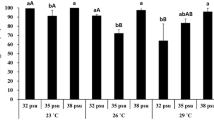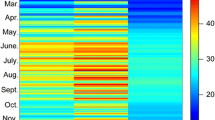Abstract
The influence of temperature over 8 time intervals on survival of cleavage stages, trochophore larvae, and straighthinge veliger larvae of Mulinia lateralis (Say) was investigated using a thermal gradient apparatus. There was a direct relationship of mortality with increased period of exposure. As the clams aged, temperature tolerance increased, with cleavage stages being most sensitive to higher temperatures and straight-hinge larvae least sensitive. Multiple-regression equations were developed to allow prediction of percentage mortalities under different conditions of temperature and time exposure. Entrainment of M. lateralis embryos and larvae in the cooling-water systems of steam-electric power plants should be as short as possible to keep mortality toa minimum.
Similar content being viewed by others
Literature Cited
Anonymous: Electric power and the environment. A report sponsored by The Energy Policy Staff, Office of Science and Technology, 71 pp. Washington, D.C.: U.S. Government Printing Office 1970.
Calabrese, A.: Mulinia lateralis: molluscan fruit fly? Proc. natn. Shellfish. Ass. 59, 65–66 (1969a).
—: Individual and combined effects of salinity and temperature on embryos and larvae of the coot clam, Mulinia lateralis (Say). Biol. bull. Marine Biology Lab., Woods Hole 137, 417–428 (1969b).
—: Reproductive cycle of the coot, Mulinia lateralis (Say), in Long Island Sound. Veliger 12, 265–269 (1970)
— and H. C. Davis: Tolerances and requirements of embryos and larvae of bivalve molluscs. Helgoländer wiss. Meeresunters. 20, 553–564 (1970).
Chanley, P. and J. D. Andrews: Aids for identification of bivalve larvae of Virginia. Malacologia 11, 45–119 (1971).
Coutant, C. C.: Biological aspects of thermal pollution. I. Entrainment and discharge canal effects. CRC Critical Rev. in environl Control 1, 341–381 (1970)
Davis, H. C. and A. Calabrese: Combined effects of temperature and salinity on development of eggs and growth of larvae of M. mercenaria and C. virginica: Fishery Bull. Fish Wildl. Serv. U.S. 63, 643–655 (1964).
Engstrom, S. L., G. F. Bailey, P. M. Schrotke and D. E. Peterson: Thermal effects of projected power growth: South Atlantic and East Gulf Coast river basins, 165 pp. HEDLTME 72-131. Richland, Wash.: Hanford Engineering Development Laboratory 1972a.
—: Thermal effects of projected power growth: North Atlantic river basins, 178 pp. HEDL-TME 72-141. Richland, Wash.: Hanford Engineering Development Laboratory 1972b.
Goodwin, C. L.: Some observation on laboratory spawning of the geoduck, Panope generosa, and the culture of its larvae. Proc. natn. Shellfish. Ass. 60 (Abstr.), 13–14 (1970).
Kinne, O.: Temperature-animals: invertebrates. In: Marine ecology, Vol. I. Pt 1. pp 407–514. Ed. by O. Kinne: New York: Wiley-Interscience 1970.
Langford, T. E.: A comparative assessment of thermal effects in some British and North American rives. In: River ecology and man, pp 319–351. Ed. by R. T. Oglesby, C. A. Carlson and J. A. McCann. New York: Academic Press 1972.
Levinton, J. S.: The paleoecological significance of opportunistic species. Lethaia 3, 69–78 (1970).
Linduská, J. P. (Ed.): Waterfowl tomorrow, 770 pp. Washington, D.C.: U.S. Government Printing Office 1964.
Löf, G. O. G. and J. C. Ward: Economics of thermal pollution control. J. Wat. Pollut. Control Fed. 42, 2102–2116 (1970).
Loosanoff, V. L. and H. C. Davis: Rearing of bivalve mollusks. Adv. Marine Biology 1, 1–136 (1963).
—, W. S. Miller and P. B. Smith: Growth and setting of larvae of Venus mercenaria in relation to temperature. J. mar. Res. 10, 59–81 (1951).
Loveland, B. E., E. T. Moul, D. A. Busch, P. H. Sandine, S. A. Shafto and J. McCarty: The qualitative and quantitative analysis of the benthic flora and fauna of Barnegat Bay before and after the onset of thermal addition. Report No. 8 to New Jersey Public Utilities Commission, 37–42. Department of Zoology, Rutgers University, New Brunswick, New Jersey 1972.
Marcy, B. C., Jr.: Survival of young fish in the discharge canal of a nuclear power plant. J. Fish. Res. Bd Can. 28, 1057–1060 (1971).
Pelseneer, P.: Sur le degé d'eurythermie de certaines larves marines. Bull. Acad. r. Belg. Cl. Sci. 279–292 (1901).
Shaw, W.: Seasonal setting patterns of five species of bivalves in the Tred Avon River, Maryland. Chesapeake Sci. 6, 33–37 (1965).
Snedecor, G. W.: Statistical methods, 5th ed. 534 pp. Ames: Iowa State University Press 1956.
Sokal, R. R. and F. J. Rohlf: Biometry, 776 pp. San Franccisco: W. H. Freeman 1969.
Steel, R. G. D. and J. H. Torrie: Principles and procedures of statistics, 481 pp. New York: McGraw-Hill 1960.
Tarzwell, C. M.: An argument for the open ocean siting of coastal thermal electric plants. J. envir. Qual. 1, 89–91 (1972).
Thomas, W. H., H. L. Scotten and J. S. Bradshaw: Thermal gradient incubators for small aquatic organisms. Limnol. Oceanogr. 8, 357–360 (1963).
Woelke, C. E.: Bioassay — the bivalve larvae tool. Proc. 10th Pacif. N. W. Symp. Wat. Pollut. Res. U.S. Dept. H. E. W., pp 113–123. Portland, Oregon: Public Health Service 1961.
Author information
Authors and Affiliations
Additional information
Communicated by J. Bunt, Miami
Contribution No. 550 of the Natural Resources Institute, University of Maryland, and Contribution No. 531 of the Virginia Institute of Marine Science.
Rights and permissions
About this article
Cite this article
Kennedy, V.S., Roosenburg, W.H., Zion, H.H. et al. Temperature-time relationships for survival of embryos and larvae of Mulinia lateralis (Mollusca: Bivalvia). Marine Biology 24, 137–145 (1974). https://doi.org/10.1007/BF00389348
Accepted:
Issue Date:
DOI: https://doi.org/10.1007/BF00389348




